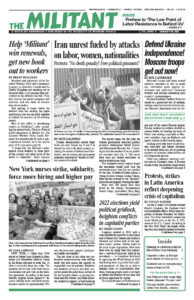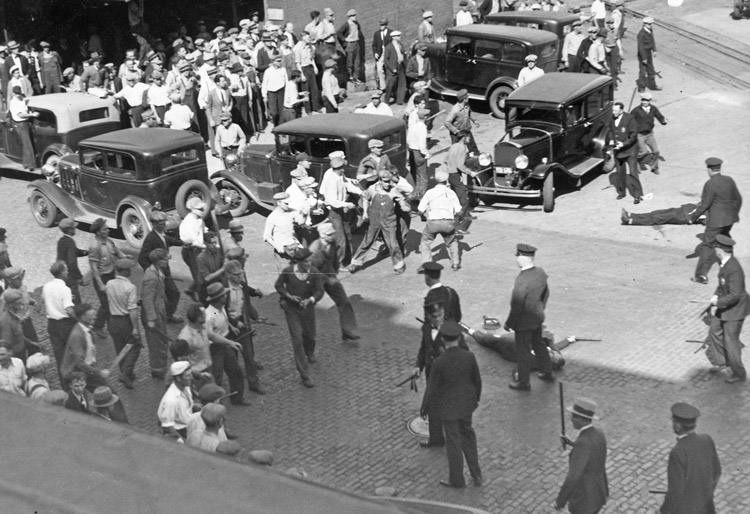The Communist League of America 1932-34 by James P. Cannon is one of Pathfinder’s January Books of the Month. Under the inspiration of the 1917 Bolshevik Revolution in Russia, Cannon helped found the Communist Party in the U.S. in 1919. He was a central leader of the Communist League of America founded in 1928 and the Socialist Workers Party a decade later. He led the international movement spearheaded by Leon Trotsky fighting to continue the proletarian internationalist course of V.I. Lenin after a bureaucratic counterrevolution was carried out under Joseph Stalin in the Soviet Union and Communist International. This 1934 excerpt is from “Minneapolis and Its Meaning,” on the historic battle won there by Teamster unionists. Copyright © 1985 by Pathfinder Press. Reprinted by permission.
Standing by itself, the magnificent strike of the Minneapolis truck drivers would merit recognition as an extraordinary event in modern American labor history. Its connection with the second wave of labor struggles to sweep the country since the inception of the NRA [National Recovery Administration], however, and its indubitable place as the high point of the present strike wave, invest the Minneapolis demonstration with an exceptional importance. …The best approach to the trade union question, the key question of revolutionary politics in the United States, is through the study and discussion of concrete examples.
The second strike wave under the NRA rises higher than the first and marks a big forward stride of the American working class. The enormous potentialities of future developments are clearly written in this advance. The native militancy of the workers, so impressively demonstrated on every strike front in recent months, needs only to be fused with an authentic leadership which brings organization, consciousness, and the spirit of determined struggle into the movement. Minneapolis was an example of such a fusion. That is what lifted the drivers’ strike out above the general run. Therein lies its great significance — as an anticipation, if only on a comparatively small, local scale, of future developments in the labor movement of the country. …
The messianic faith in the Roosevelt administration which characterized the strike movement of a year ago and which, to a certain extent, provided the initial impulse for the movement, has largely disappeared and given place to skeptical distrust. …
[T]he striking workers now depend primarily on their own organization and fighting capacity and expect little or nothing from the source to which, a short year ago, they looked for everything. …
In these great struggles the American workers, in all parts of the country, are displaying the unrestrained militancy of a class that is just beginning to awaken. This is a new generation of a class that has not been defeated. On the contrary, it is only now beginning to find itself and to feel its strength. And in these first, tentative conflicts the proletarian giant gives a glorious promise for the future. …
[T]he organization drives and the strikes, barring incidental exceptions, are conducted within the framework of the AFL unions. The exceptions are important and should not be disregarded. At any rate, the movement begins there. Only those who foresaw this trend and synchronized their activities with it have been able to play a part in the recent strikes and to influence them from within.
The central aim and aspiration of the workers, that is, of the newly organized workers who are pressing the fight on every front, is to establish their organizations firmly. The first and foremost demand in every struggle is: recognition of the union. With unerring instinct the workers seek first of all the protection of an organization. …
[T]he Minneapolis strike was marked by certain different and distinct aspects which are of fundamental importance. In other places, as a rule, the strike militancy surged from below and was checked and restrained by the leaders. In Minneapolis it was organized and directed by the leaders. In most of the other strikes the leaders blunted the edge of the fight — where they could not head it off altogether, as in the case of the auto workers — and preached reliance on the NRA, on General [Hugh] Johnson, or the president. In Minneapolis the leaders taught the workers to fight for their rights and fought with them. …
The strike wave of last year was only a prelude to the surging movement we witness today. And just as the present movement goes deeper and strikes harder than the first, so does it prepare the way for a third movement which will surpass it in scope, aggressiveness, and militancy. Frustrated in their aspirations for organization by misplaced faith in the Roosevelt administration, and by the black treachery of the official labor bureaucracy, the workers will take the road of struggle again with firmer determination and clearer aims. And they will seek for better leaders.
Then the new left wing of the labor movement can have its day. The revolutionary militants can bound forward in mighty leaps and come to the head of large sections of the movement if they know how to grasp their opportunities and understand their tasks. For this they must be politically organized and work together as a disciplined body. … They must get inside the developing movement, regardless of its initial form, stay inside, and shape its course from within.
They must demonstrate a capacity for organization as well as agitation, for responsibility as well as for militancy. They must convince the workers of their ability not only to organize and lead strikes aggressively, but also to settle them advantageously at the right time and consolidate the gains. …
On this condition the new left wing of the trade unions can take shape and grow with rapid strides. And the left wing, in turn, will be the foundation of the new party, the genuine communist party. On a local scale, in a small sector of the labor movement, the Minneapolis comrades have set an example which shows the way. The International Communists have every right to be proud of this example and hold it up as a model to study and follow.


